Catalogue and magic properties of the stone -->rus
TURQUOISE

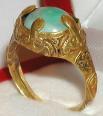
 Description characteristic of the mineral.
Description characteristic of the mineral.
A question is actual for this group, how to distinguish from an imitation. Connection of water phosphates and aluminium. Chemical composition is inconstant. Chemical composition: CUO - 9.57%, Al2O3 - 36,84%, Pb2O3 - 34,12%, H2O - 19,47%. Microcrystalline the masses of reniform form are ordinary or as crusts, veins and wrong form of accumulations. Permanent admixtures - Sulphur, Sulfur, Brimstone, zinc, barium, chrome, nickel, titan and other. Blue cyan sky turquoise is characteristic for untouched weathering turquoise, depends on maintenance of copper. In the process of senescence and at a substitution the second minerals the role of oxydic iron Fe increases, silica, calcium, magnesium, zinc, strontium, owing to what turquoise greens. Greenish, brown and other tones are conditioned oxydic iron Fe, substituting for a copper. Admixture of halloysite, kaolinite and wavellite give whitish spots. Often turquoise contains inclusion quartz, Pyrite and other minerals and white inclusion has often. Turquoise processed easily.
Turquoise - very much hydroscopic material. Wares from it it is needed to guard from the sharp overfalls of temperatures, heating, from influence of acids, abrasives and fumes, they can not be cleaned in soapy solutions. The most valuable is consider blue turquoise. Minerals turquoises, rugger brown and black veins, and also turquoise of yellow-green color, have more low jeweller quality and are for a sale cheaper natural celestial sky-blue. The best in mine deposits are the world acknowledged in Iran and Arizona. In other mine deposits efflorescent turquoise is more pale and less dense, with a depth marked perceptibly more dense and bright tincture differences of blue and greenish tints (what more oxides of iron Fe, the more green turquoise). The varieties of turquoise with the thin veins of black carbon material or oxides of iron Fe at blue tone name a spider web or reticulated and sell dearer.
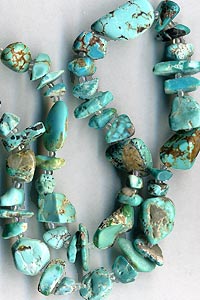 Turquoise - one of the most most beautiful jeweller stone, known humanity from deep antiquity. Decorations and talismans from turquoise find at excavations of ancient cultures in Central America, Egypt, Central Asia. In the moslem world turquoise used especially large love and popularity. In jeweller wares turquoise is usually used as cabochons, often wrong form, it well combines with other jeweller stone, and also with silver and gold. In antiquity turquoise was not mounted in gold, because it was considered that it lost the beauty here. Find application and laminas of turquoise - for encrustation on a metal, tree and other materials.
Turquoise - one of the most most beautiful jeweller stone, known humanity from deep antiquity. Decorations and talismans from turquoise find at excavations of ancient cultures in Central America, Egypt, Central Asia. In the moslem world turquoise used especially large love and popularity. In jeweller wares turquoise is usually used as cabochons, often wrong form, it well combines with other jeweller stone, and also with silver and gold. In antiquity turquoise was not mounted in gold, because it was considered that it lost the beauty here. Find application and laminas of turquoise - for encrustation on a metal, tree and other materials.
Usually turquoise is a micro- and cryptocrystalline aggregate, having veins, forming tumours, inclusion of wrong form, kidney-shaped educations. As crystals it be found extraordinarily rarely (sizes of separate crystals of turquoise were 0,3 mm and less). Turquoise is opaque, in thin cleaved facet chip split examines with transparent. Colouring of it at standards composition of which is near to theoretical, bright, sky-blue. But enough often colouring of turquoise of bluish- and apple-green, sometimes even greenish-brown. Turquoise can be discoloured in the sunshine. Brilliance of turquoise is glass or waxen. The mine deposits of turquoise are related to the barks of weathering of mountain rocks, containing copper-sulfide mineralization.
The mine deposits of turquoise in the CIS are known in Central Asia in Kuraminskiy and Kyzylkumskiy calaite turquoise districts region. Turquoise on territory of Central Asia obtained from deep antiquity, what the numerous ancient making testify to. Central Asiatic turquoise be found as streaks, tumours, lenses, wrong excretions. The color of it is extremely various: bluish- and celestial-blue with all of transitions in green, brown-green and brown. Found out the displays of turquoise in Azerbaijan and Georgia. Highest quality turquoise from deep antiquity and to the present tense obtained in Iran, northwest Nishapur. Turquoise is extracted by hand. The largest mine deposits are in the USA in the states Arizona, Colorado, Nevada, to New Mexico. The mine deposits of turquoise are known in Chile, Peru, Mexico, National Republic of China, Australia.
Turquoise of natural natural color always stands dearer than the artificially painted or artificial (even blue) analogues, the supplies of jeweller natural turquoise are gradually closed, therefore it will be in course of time only to rise in a price. Turquoise unchanging is in large demand, it is often counterfeited therefore. Green turquoise stands in 3 times cheaper blue. To the world market 60% turquoises acts in the ennobled kind, in particular approximately 80% is ennobled American Arizonan turquoise. Diagnostics of turquoise is very difficult in connection not only with the presence of synthetic and ennobled stone but also with the use of enormous number of imitations.

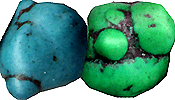 Turquoise nowhere be found as large pieces or continuous the masses. Hunches often talk about an imitation. Today turquoise is often ennobled are dyed in a solid color the coloured beeswax, impregnating with an epiphase. This turquoise a few more proof to external influences. The porous surface of off-grade turquoise is saturated with dyes. The ground up is also impregnated with to powder or ultrafine pieces and the turquoise pressed under high pressure (the best imitation, in-use and in jeweller wares).
Turquoise nowhere be found as large pieces or continuous the masses. Hunches often talk about an imitation. Today turquoise is often ennobled are dyed in a solid color the coloured beeswax, impregnating with an epiphase. This turquoise a few more proof to external influences. The porous surface of off-grade turquoise is saturated with dyes. The ground up is also impregnated with to powder or ultrafine pieces and the turquoise pressed under high pressure (the best imitation, in-use and in jeweller wares).
Presently wide distribution was got by synthetic turquoise (on a photo on the right, enough near on composition to natural, usually bright blue with spider web veins or whitish disseminations) and imitation of turquoise, it 80% market of turquoise. Viennese turquoise (on a photo on the left) is the thermally treated and pressed mixture of malachite, monodiaspores and phosphoric acid. Turquoise under the name a neolith - from the phosphate of copper and monodiaspore. The bright and even sulphur colouring, not typical for natural turquoise appears in such synthetic turquoise. It grow black at heating, but not crack chink. Synthetic material is very homogeneous, contains microimpurity of the painted or whitish particles. At socks such synthetic turquoise is good that it never loses the color and does not wipe oneself.
Turquoise is very often counterfeited a plastic (at heating smelt and stinks characteristically, it is not porous), superficial painting of bone and similar materials (a bone is white inwardly, the method of separation is a capacity of organic matter for burning), from glass and porcelain, painting Chalcedony, low-grade Lazurite, lapis lazuli, howlite and other. There are also imitations from the burnt gypsum and alabaster, and also superficially painted gray-white of natural mineral of howlite (kaulite) - for today it is a biggest-selling imitation and most credible on an uninitiated look imitation. The distinguishing feature of imitation from soft howlite is a rapid abrasion of the painted over epiphase, this imitation at carrying very quickly becomes greyish and whitish, loses the commodity kind and is the worst.
Magic properties of stone.
There is prejudice, as though turquoise of green color allegedly "old and bad", and blue it younger and better. It is a lie. Turquoise of blue, turquoise and green color has quite identical century. Turquoise of deep green color also costs expensive, but unlike blue its colouring is more proof. A color of turquoise is a make presence of admixtures. Turquoise indeed can in course of time or from the strong heating it is insignificant become green from oxidization of being in it iron Fe, but it however will outvalue the synthetic painted standard. In all of ages turquoise was considered and continues to be considered a stone-talisman, bringing it to the proprietor cognition of truth, true, ability to be taught higher sciences, especially to understand the spiritual world and perfect itself in this world. Contemplation of turquoise helps to understand spiritual books. This stone is great reconciler and eradicator wicked. As an amulet blue turquoise is unmatched for the children of any ages, drives away from them wicked essences. Turquoise was often inserted in handle of swords, because this stone is able to protect warriors and do their weapon irresistible. Getting up on a fight against an evil always had turquoise and as a protectress, and as conservator, custodian. It also warns a proprietor against the different sort of sectarians, members of black orders et cetera If the special danger threatens a proprietor, stone can sharply decolorize or quite to scatter. It is considered that turquoise rescues from premature, foolish death. It keeps a proprietor from poverty and instrumental in the positive decision of all of questions, if he applies for it to authorities. Stone does people more well-disposed and especially useful that, who is overtaken by the bursts of anger. It guards horse and horsemen, why and was the decoration of trappings.
Izdrevle famous as stone happiness. Grants the world and prosperity all of people, except for villains (which it hoodoos and does not give to be done an evil), takes a danger. Turquoise also comes forward character of the out-of-limit world, character of spiritual sky, can attain which only that, who will get through death. For greeks it was stone Aphrodite. Acteki named turquoise the "tears of goddess of sky". Connection with high womanish appearances was done turquoise in presentations ancient the stone of love. Persians considered even, that bones of the people, lost from love, grow into turquoise. Large popularity was used by turquoise in the moslem world - considered the stone of victory, mighty talisman. On territory of Polovtsians, Caucasus and Central Asia was an obligatory detail in the wedding attire of fiancees. Turquoise - stone success and world, tames quarrels and enmity between people, pacifies unjustified anger and spiteful thoughts, character of unchanging and faithful love.
From point of magic young and young turquoise light-blue, as sky, colors, "feed" a people the energy and is the stone of unconcerned and carefree Venus and befits young and young. Green turquoise - mature stone, force and wisdom of Saturn is hidden in which, therefore the strong can carry him and wise. Green turquoise looks at oneself appropriately on psychologically mature people, and blue - on children and teenagers. That, who owns turquoise of any color, never has failing in a money, the words of him meet circumferential with attention.
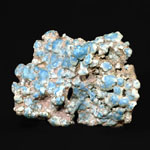
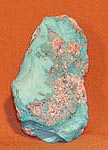

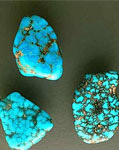

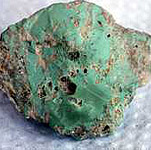
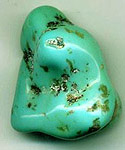
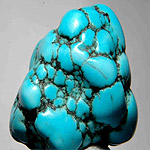
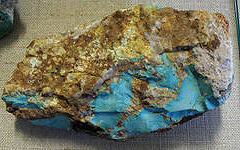


HOWLITE (KAULITE, HAULITE)
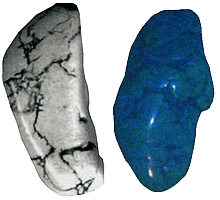 Howlite. Synonyms: kaulite, calcite-boron-silicon. We turn the special attention on it natural mineral, which today often give out for turquoise. Color of natural howlite usually white or grey, often there are minerals with brown and black veins (these veins are reminded by the veins of turquoise). A mineral is adopted in honour his discoverer - Canadian geologist Henry Gove. A howlite is the borosilicate of calcium of Ca2B5Si09(0H) 5. It is cheap material. In the ultraviolet light tiny, the barely noticeable with a naked eye crystals of howlite sometimes shine rather yellow or whitish light (these crystals also can be looked over in strong magnifying glass).
Howlite. Synonyms: kaulite, calcite-boron-silicon. We turn the special attention on it natural mineral, which today often give out for turquoise. Color of natural howlite usually white or grey, often there are minerals with brown and black veins (these veins are reminded by the veins of turquoise). A mineral is adopted in honour his discoverer - Canadian geologist Henry Gove. A howlite is the borosilicate of calcium of Ca2B5Si09(0H) 5. It is cheap material. In the ultraviolet light tiny, the barely noticeable with a naked eye crystals of howlite sometimes shine rather yellow or whitish light (these crystals also can be looked over in strong magnifying glass).
A howlite is easily dyed in dark blue, turquoise, green and any other tones and very often comes forward as a substitute of turquoise, and also red or rose corals. It natural mineral. An imitation turns out so exact, that salespeople consciously give out the painted howlite for the real turquoise. From a howlite cut beads, cabochons and even small figurines. Polished surface of howlite of flash, as if porcelain (another difference from turquoise). Main mine deposits are located in New Scotland (Canada). There is a howlite and on territory of California (USA). Turkvenit is a variety of howlite.
The superficial painting over of howlite is very quickly worn down. Therefore we recommend to acquire inexpensive decorations as beads and pendants from the unpainted over unennobled white howlite (caulite), because at his carrying the commodity type of good will not be lost. In beads he will a bit remind white turquoise and intrigue circumferential, saving the interesting picture of veins and cracks and all of dignities of natural stone. Achroos howlite on sale be found not often.
Magic properties of stone.
The white color of howlite is symbolized by innocence and at the same time personifies force of human dignity. Decorations with a howlite will help to pacify anger, drive away anxious ideas and emotions. There is a popular belief, that a howlite is brought by quiet sleep and helps to remember past sleeps. This mineral intensifies sense of wonderful.
Poisonous and radioactive risky hazardous cargo stone and minerals
** - are poisonous stone and minerals (mandatory verification is in the chemical analysis laboratory + on toxicity)
** - are radioactive stone and minerals (mandatory verification on a regular dosimeter + prohibition on the opened sales in the case of radio-activity over 24 milliroentgens / hour + additional measures of protection of people)
All of rare stone are subject obligatory verification on a regular dosimeter on the possible level of radiation and in a chemical laboratory on absence default of poisonous and evaporating components, dangerous for a human people and environment nature
- Free download article Very dangerous and potentially dangerous stone and minerals are in Medical stone therapeutics, with pictures, 2010 year, format of PDF, 2.80 Mb (Presentation from scientific of author K.305 of pictures of very dangerous and potentially dangerous natural stone and minerals which on a bad motive or criminal indifference can be illegally used in criminal and "underground" "Medical stone therapeutics"). Rus langv.
A catalogue of stone is all of stone in alphabetical order
- Signs of travelling traffic lane markings - to transportation and marking of dangerous load Policy Rules
- Rules of Road Transportation of Especially Dangerous Loads, Hazardous cargo commodity, signs index plate
